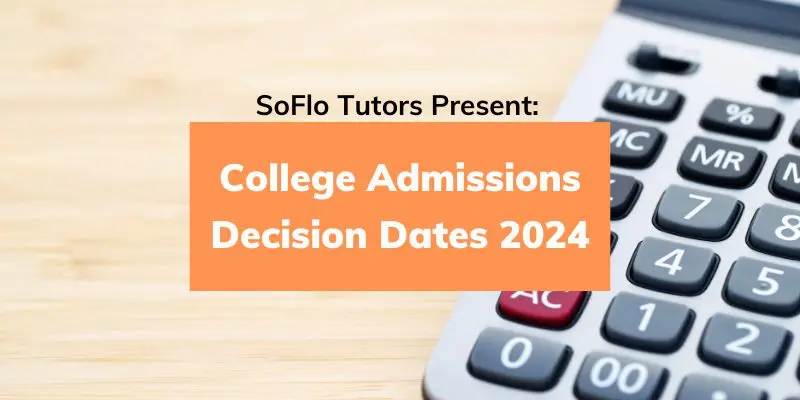
Waiting To Hear Back From Schools Can Be Stressful…
But it is important to remember the hard work that you put into your academic career, regardless of decision outcomes. In this blog, I will list some dates that particular schools have given as an estimated time of when students should hear back about decisions. I will also talk about what rolling admissions are, what a wait-list is (and what to do if you’re on one), and go over some tips for finding out your school’s decision date if your school was not included in the list below.
General Estimate Of When You Will Hear Back From Institutions
Ivy Leagues: Sometimes referred to as ‘Ivy Day’, this day is the anticipated date that students will hear back from their Ivy League Universities of choice. For the 2024 admission cycle, students can expect to hear a decision from their Ivy League schools anywhere from late March to early April. However, Ivy Day 2024 is expected to fall on March 28th with a majority of the Ivy schools sending out their decisions then.
Of course this is an estimate, and it may be the case that some schools do not release their decisions on Ivy day. For those other schools, refer to the section below: How To Check Your Schools Decision Date.
Universities and Colleges: There is typically no precise date by which most universities and colleges announce their decisions, as the process of admissions is vastly different across universities and colleges (especially depending on the students desired area of study), however, a general rule of thumb is that students will hear back from their desired institutions one to three months after they applied. However, for a more accurate date to expect your decision from a particular institution, refer to the section below: How To Check Your Schools Decision Date.
What Are Rolling Admissions?
When a school offers a rolling admission, it means that they review applications on an ongoing basis until all of the remaining slots have been filled by prospective students, or a deadline has been reached.
Rolling admissions differ from a traditional application. The traditional application process is one with a single, static date by which all applications must be submitted by and a fixed date for the release of decisions.
The rolling admission process proceeds thus:
Students will apply to the program of their choice as long as there are still slots available and the overarching deadline has not been reached. Students can then expect to hear their decision in 4-6 weeks (roughly) of when they had applied, regardless of whether they applied when the admission opened, or was nearing close.
This, of course, does not mean that students can get by with a low quality application. Rolling admissions can still be very competitive. It is just a different approach that some schools use for the admissions process.
When To Expect Decisions From Ivy League Schools:
Here is a list of all of the Ivy leagues and when students can expect to hear back from them about their decisions. All of the above information is an estimate, it is always possible that students may hear before or after the estimated time here mentioned.
| Brown University | Early April |
| Columbia University | Early April |
| Cornell University | Early April |
| Dartmouth College | Late March/Early April |
| Harvard University | Late March |
| University of Pennsylvania | Rolling Admission |
| Princeton University | Late March/Early April |
| Yale University | April 1st |
When To Expect Decisions From 15 Popular Institutions
Here is a list of 15 popular schools and when you might expect to hear back from them!
| Massachusetts Institute of Technology | Mid-March |
| Stanford University | Early April |
| University of Florida | Last Friday in March |
| Duke University | Late March |
| Johns Hopkins University | Late March |
| Northwestern University | Late March |
| University of Chicago | Late March |
| University of California, Berkeley | Sometime within the month of March |
| University of California, Los Angeles | Sometime within the month of March |
| Rice University | April 1st |
| Vanderbilt University | Mid-March |
| University of Notre Dame | Late March |
| University of Michigan, Ann Arbor | Early April |
| Georgetown University | April 1st |
| University of North Carolina, Chapel Hill | Late March |
How To Check Your Schools Decision Date:
In order to check your schools decision date, or the estimate that they provide, go to their admissions page website. On their admissions page website they should have an estimated time, or a set time, that undergraduate first-year applicants can expect to hear about the decision made by the school.
If this information is not readily available, I recommend simply searching ‘When should I expect a decision for undergraduate admission to [Your school’s name]’ into the search bar. If an immediate answer does not come up for the current year, you may be able to use past years provided as an estimate of the time you are likely to hear back from them.
Another tip is to keep up-to-date with your school of choice via social media, particularly Twitter (or ‘X’) to read up on updates they may directly provide the prospective student class.
What To Do If You Were Wait-listed:
If your decision comes back as a wait-list, the first step of action is to NOT decline any other offers that you may have until you are certain of admission into that institution which wait-listed you. Say for example you got into Duke, but your top choice was Harvard and Harvard wait-listed you. Do not decline Duke because you were wait-listed at Harvard. A wait-list is not a guarantee, simply wait it out.
In their offer letter to you, most institutions will provide you a deadline by which you must accept or decline the offer. Wait until you are clear on your stance on the waitlist before declining other offers.
About The Author
Dahlia is a graduate of Florida State University earning a B.S. in both philosophy and psychology. She now attends University of Wisconsin-Milwaukee, pursuing a M.A. in philosophy.









